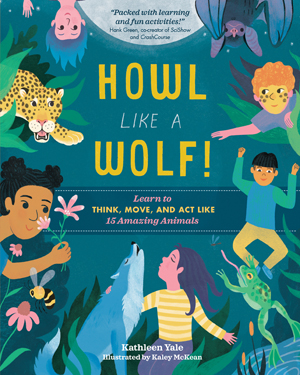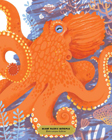| ________________
CM . . .
. Volume XXIV Number 40. . . .June 15, 2018

 |
Howl Like a Wolf!
Kathleen Yale. Illustrated by Kaley McKean.
North Adams, MA: Storey Publishing (Distributed in Canada by Thomas Allen & Son), 2018.
80 pp., hardcover, $26.95.
ISBN 978-1-61212-905-1.
Grades 1-4 / Ages 6-9.
Review by Dave Jenkinson.
*** /4
|
| |
|

Excerpt:
HOWL like a WOLF
Ayhoooooooo! Hear me howl! I’m a gray wolf. Well, that’s my name, but actually, my thick, warm fur can be gray, brown, black, or even pure white.
I’m a social animal, so I like to hang out with my fellow wolves. I live in a pack with my parents, older siblings, and littermates. My parents are the alphas – that means they’re in charge – and the rest of us follow their lead.
...
Now you be a wolf!
Your main mission is to get your pack together, protect your territory, and, of course, give a good howl!
Howl Like a Wolf! is a combination information and activity book in which readers are introduced to 15 different living creatures and then are invited to mimic some of the behaviours that are typical of that creature. Included in the book are: gray wolf, emperor penguin, African elephant, little brown bat, giant Pacific octopus, diamondback rattlesnake, great bowerbird, North American beaver, leopard, humpback whale, Western honeybee, common raven, striped skunk, Columbia spotted frog and white-tailed deer. Each chapter title indicates its activity focus, and so youngsters will be called upon to “SNEAK like a LEOPARD” or “DANCE like a HONEYBEE” or “SPRAY like a SKUNK”.
Each chapter is divided into two parts (see excerpt) with the first being factual information about the “animal” that is related in the first person by the animal, itself. This section also contains third person fact boxes which provide additional information about the animal. In “HOWL like a WOLF”, for example, a text box headed “WHAT BIG TEETH YOU HAVE! describes, in part the differences between a wolf’s teeth and those of a pet dog.
 
The second part of each chapter, written in second person, provides the activities in which the reader can become involved in order to act like the chapter’s animal. The activities flow directly from the directions that appear at the beginning of this section. For instance, in the “KEEP COOL like an ELEPHANT” chapter, this section is introduced by:
Now you be an elephant!
Your elephant mission is to use your nose and ears to keep cool and your powerful memory to keep track of all your herd members. Put on your thinking cap!
Youngsters are then invited to use a garden hose as a pretend trunk, to make elephant ear fans, and to play a memory game. Yale also throws some fact boxes into the activities section. In this case, readers are asked, “Did you know elephants are one of only a few animals who can recognize their own reflections in a mirror?”
The chapters alternate between being six pages and four pages in length, with the pages being equally divided between the information and activity content. Each chapter is introduced by McKean’s full-page illustration of the focal animal, and more of her illustrations appear throughout the chapter to support the fact boxes or the suggested activities.
The closing page provides the URL for a website from which youngsters or adults can download masks of 13 of the book’s 15 critters (no octopus or whale). Wearing the appropriate mask while carrying out some of the suggested activities could add to the book’s facts and fun.
In selecting her content, Yale has chosen both the familiar and the unfamiliar. Her use of the first person in the information section and the second person in the activity portion will be effective in engaging readers. Some readers may choose to read only the book’s factual portions while teachers might select particular animals and activities to support curricular needs. Kindergarten teachers and parents of preschoolers might also want to look at the activities to see if they could incorporate some of them into their classrooms or homes.
Recommended.
Dave Jenkinson, CM’s editor, lives in Winnipeg, MB.

To comment on this title or this review, send mail to cm@umanitoba.ca.
© CM Association
CC BY-NC-ND
Hosted by:
University of Manitoba
ISSN 1201-9364
|
This Creative Commons license allows you to download the review and share it with others as long as you credit the CM Association. You cannot change the review in any way or use it commercially.
Commercial use is available through a contract with the CM Association. This Creative Commons license allows publishers whose works are being reviewed to download and share said CM reviews provided you credit the CM Association. |
Next Review | Table of Contents for This Issue - June 15, 2018.
CM Home | Back Issues | Search | CM Archive | Profiles Archive
|


